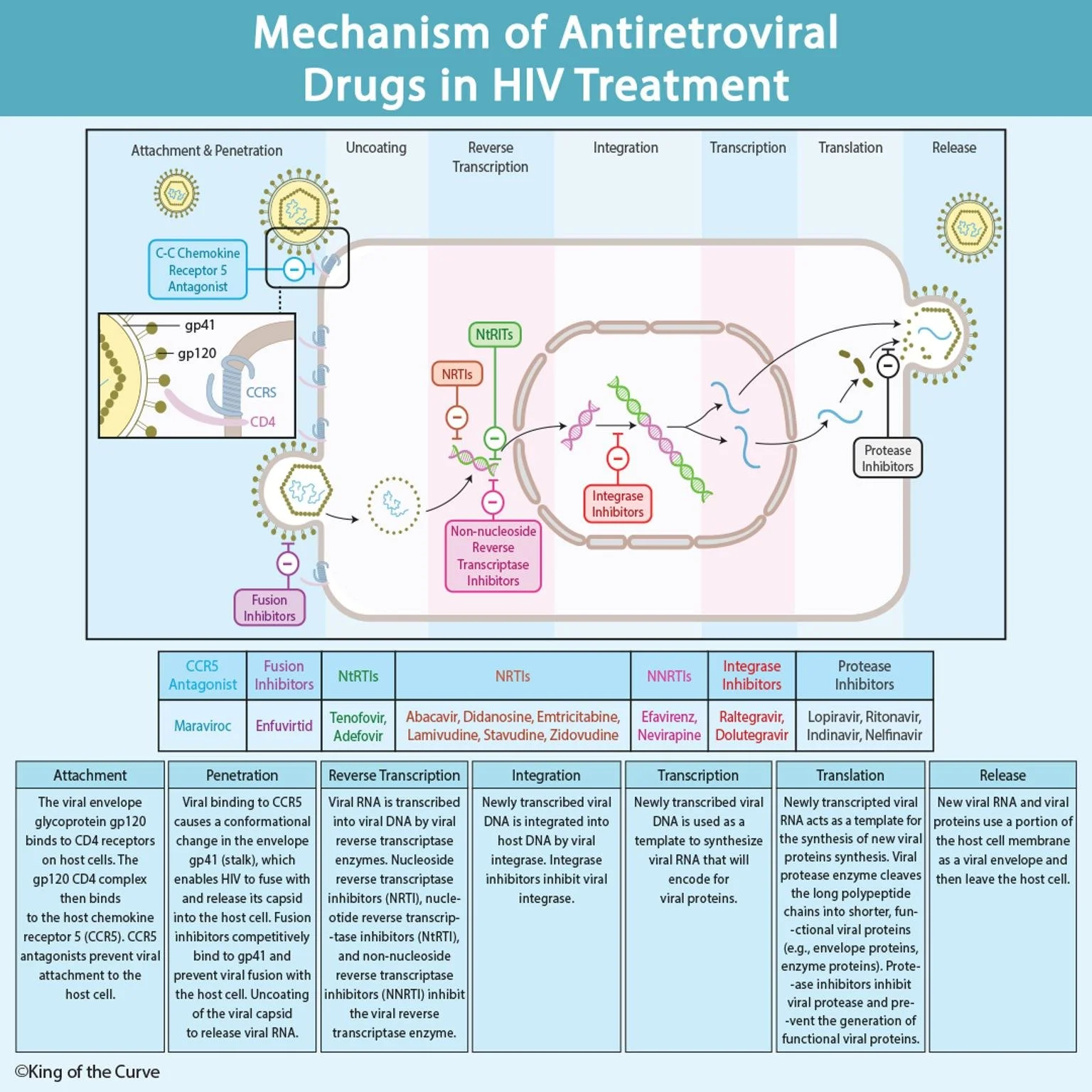🧬 Mechanism of Antiretroviral Drugs in HIV Treatment
The treatment of HIV relies on antiretroviral therapy (ART) — a combination of drugs designed to target different stages of the viral life cycle. These medications don’t cure HIV, but they effectively suppress viral replication, preserve immune function, and prevent transmission. Understanding how these drugs work provides insight into why combination therapy is essential for long-term viral control and prevention of resistance.
🔹 The HIV Life Cycle and Drug Targets
HIV infects CD4+ T cells through a complex series of steps — from attachment and penetration to reverse transcription, integration, and replication. Each class of antiretroviral drug acts at a specific stage of this process:
| Stage | Drug Class | Mechanism of Action | Examples |
|---|---|---|---|
| Attachment & Penetration | CCR5 Antagonists, Fusion Inhibitors | Block viral binding to the host cell or prevent membrane fusion. | Maraviroc, Enfuvirtide |
| Reverse Transcription | NRTIs & NNRTIs | Inhibit reverse transcriptase, preventing conversion of viral RNA to DNA. | Tenofovir, Abacavir, Efavirenz |
| Integration | Integrase Inhibitors | Block integration of viral DNA into the host genome. | Raltegravir, Dolutegravir |
| Translation & Assembly | Protease Inhibitors | Prevent viral protein processing, producing non-functional viral particles. | Lopinavir, Ritonavir |
🔸 Combination Therapy: The Key to Success
ART is most effective when multiple drugs are used together — typically from at least two different classes. This multi-targeted approach reduces the likelihood of viral mutations, ensuring that the virus cannot easily develop resistance. A typical regimen includes two NRTIs combined with either an NNRTI, integrase inhibitor, or protease inhibitor.
The integration of drugs targeting different mechanisms allows clinicians to tailor therapy for individual patients based on viral load, CD4 count, and drug tolerance. Importantly, modern therapies also reduce pill burden and side effects, improving patient adherence.
💊 Drug Resistance and Adherence
One of the greatest challenges in HIV management is antiretroviral resistance, which occurs when the virus mutates and becomes less susceptible to one or more drugs. Even minor lapses in adherence can lead to subtherapeutic drug levels, allowing the virus to replicate and mutate. Once resistance develops, treatment options become limited, and viral suppression becomes difficult to maintain. This is why strict adherence to ART — taking medications at the same time every day without missing doses — is essential for long-term success. Educational counseling and once-daily combination pills have greatly improved adherence rates globally.
🧠 Clinical Insight: Why Mechanistic Understanding Matters
Understanding the mechanism of action is vital for both clinicians and students. For instance, CCR5 antagonists are only effective in patients with the CCR5-tropic strain of HIV — necessitating a tropism assay before prescribing. Similarly, protease inhibitors must be boosted with pharmacokinetic enhancers (e.g., ritonavir) to maintain effective blood concentrations.
Recognizing these mechanisms helps in managing drug resistance, side effects, and potential interactions with other medications.
💪 A Step Toward Functional Cure
While current antiretroviral drugs cannot completely eradicate HIV from the body, ongoing research focuses on long-acting formulations, gene editing (CRISPR-Cas9), and immune-based therapies that may one day lead to a functional cure. Until then, consistent ART remains the cornerstone of HIV management — turning what was once a fatal disease into a manageable chronic condition.
📢 Call to Action
Are you preparing for exams like USMLE, MCAT, or medical board reviews?
Join King of the Curve, where complex topics like HIV pharmacology, immunology, and infectious disease mechanisms are made simple through visual learning and evidence-based explanations.
Explore interactive diagrams, quizzes, and videos that help you master medicine, one curve at a time!
Frequently Asked Questions (FAQs)
-
Aim for 4-6 focused hours, ensuring you incorporate breaks to avoid burnout.
-
Practice mindfulness techniques, take practice exams under realistic conditions, and maintain a balanced lifestyle.
-
Set short-term goals, seek support from mentors, and reward yourself for small achievements.
-
Regular exercise improves focus, reduces stress, and enhances overall mental clarity.
-
KOTC offers personalized learning tools, gamification features, and adaptive question banks to help students stay on track without burnout.


